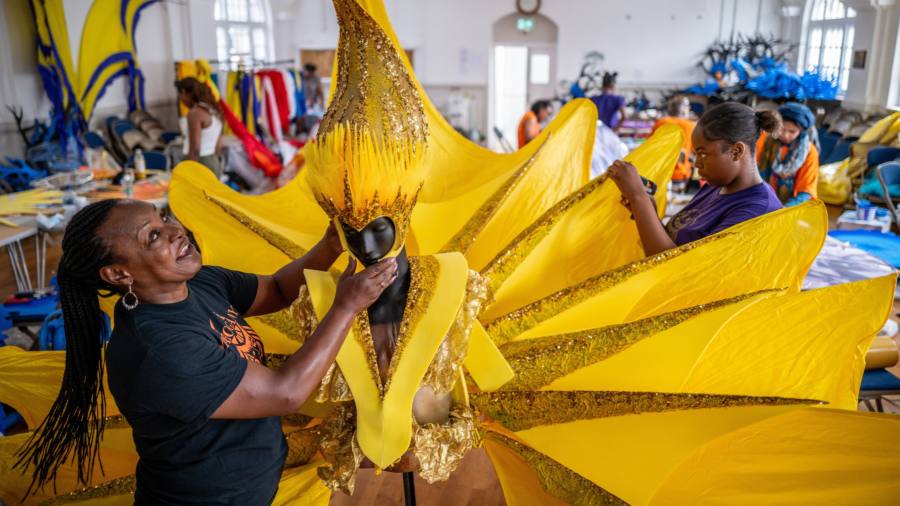As night falls in west London, the 135-year-old Tabernacle is abuzz with days to go before the return of Europe’s largest street event. Downstairs in the church-turned-community centre, women and girls put the last touches to vibrant feather backpacks. Upstairs, a rehearsal by steel pan players produces a deep, rhythmic sound.
For the roughly 90 members of Mangrove Steelband, Notting Hill Carnival, the world’s second biggest after Rio, is a unique occasion to share their Caribbean heritage and love of music with the 2mn revellers expected to converge on the Royal Borough of Kensington and Chelsea this weekend.
“Carnival is a good way for people of different ages and races to come together and have a good time,” said band member Kiko Johnson, 16, who will be attending for the first time. “There’s nothing better than indulging in your culture.”
For the hundreds and thousands of their children and grandchildren, marking the contribution of those who migrated from the Caribbean to Britain last century has special resonance this summer.
Seventy-five years ago HMT Empire Windrush docked at Tilbury in Essex. The arrival of the 492 men, women and children on board was the start of a wave of migration from Britain’s colonies to the so-called Mother Country and catalysed what authors Mike and Trevor Phillips have called “the irresistible rise of multiracial Britain”.
Members of the so-called “Windrush generation” brought with them the customs and cultures of their homelands and were integral in establishing the carnival.
After race riots in the west London neighbourhood of Notting Hill in 1958 — sparked by a white gang’s assault of Majbritt Morrison, a Swede married to a Jamaican — Trinidadian-born journalist and activist Claudia Jones organised “Claudia’s Caribbean Carnival”.
The event was held at St Pancras Town Hall in January 1959 and featured calypso, steel pans and a Carnival Queen contest. Although it was televised nationally by the BBC, Jones aimed principally to improve local community relations.
It “symbolises the unity of our people resident here and of all our many friends who love the West Indies”, she noted in a souvenir programme issued in 1960 — just nine months after the racially motivated, and still unsolved, murder of 32-year-old Antiguan carpenter Kelso Cochrane in nearby Ladbroke Grove.
By 1966 the carnival proper had come into being, on the back of a parade from Earl’s Court to Ladbroke Grove arranged two years earlier by community organiser Rhaune Laslett. Over time, Sunday became “children’s day”, with Monday designated for adults. Saturday’s highlight is Panorama, a national steel band competition.
This summer, alongside the Windrush anniversary, organisers are marking a milestone in carnival’s own story. Fifty years ago, two of the five core artistic elements were introduced in the form of sound systems and “mas” or masquerade bands, which walk and dance the parade route in flamboyant costumes.
Commemorating 1973 is important because “the blueprint was put down [then]”, said Matthew Phillip, chief executive of Carnival Village Trust, which oversees the event.
“Carnival has lasted because of its organic nature. There isn’t a central body deciding on themes . . . [but rather] over 150 creative directors curating their own content, with artistic discretion,” he added. “It means a lot to so many people. The opportunity to express themselves freely, and celebrate togetherness, is really important.”
Since taking the helm in 2018, Phillip has sought to strengthen internal procedures following criticism of CVT’s governance and the conviction of a former finance director for stealing funds.
He also hopes to cement “really good relationships” with the private sector to support performers through sponsorships, with most of carnival’s costs currently met by grants from RBKC, Westminster city council and the Greater London Authority.
Seduction City, carnival’s first — and to-date only — all-female sound system could benefit from extra support.
Founder Marilyn Dennis said that three decades after she began performing at “this microcosm of the Caribbean”, her group and sound system culture more broadly are “in a good place, but it’s very, very expensive to get into carnival. And if we’re not able to attract commercial funding, it’s difficult to sustain”.
She added: “There’s nowhere on this planet that you can listen to 38 sound systems, especially a female one. We’re the real deal.”
Trinidad-born former NHS midwife Allyson Williams is hoping the emphasis on the Windrush generation, who “were instrumental in establishing the face of multicultural Britain”, will remind carnival goers about the “Windrush scandal”.
The affair, which came to light in 2017, saw UK Commonwealth citizens lose jobs and access to the NHS, and even be removed from Britain, because they could not prove their right to live in the UK, with some dying before they received government compensation.
“Carnival is both serious and fun. It’s intended to showcase the artistic quality of our designers, but it’s also about claiming space because our history is not readily recorded,” said Williams, who led mas band Genesis with her late husband Vernon until 2002 and is now a carnival trustee.
“If you don’t understand where you’re coming from, you will never understand where you’re going.”
As Notting Hill has become more wealthy and the popularity of carnival has soared, some locals have objected to the disruption and sporadic violence around the event.
Williams believes opposition has eased thanks to better communications with residents. She argues that focusing on problems fails to acknowledge the “bigger picture” of how much the event means to young people. It also ignores the money carnival generates — estimated at £93mn two decades ago in a review commissioned by the London Development Agency, the only study of its kind.
Back at the Tabernacle, Kishan Shorter, who manages the distribution of sheet music as Mangrove’s drillmaster, is aiming for the top of the Panorama leaderboard on Saturday. Beyond this year’s rivalries and celebrations, the 26-year-old, who took up the steel pan at primary school, believes carnival has a healthy future.
“It’s a continuation of an expression of freedom, an expression of culture, especially in this country, where it wasn’t always as acceptable as it is now,” he said.
“A lot of people think carnival is putting on pretty costumes but it used to be a form of telling a story, and that’s a message that can’t be spread far enough.”
Read the full article here




